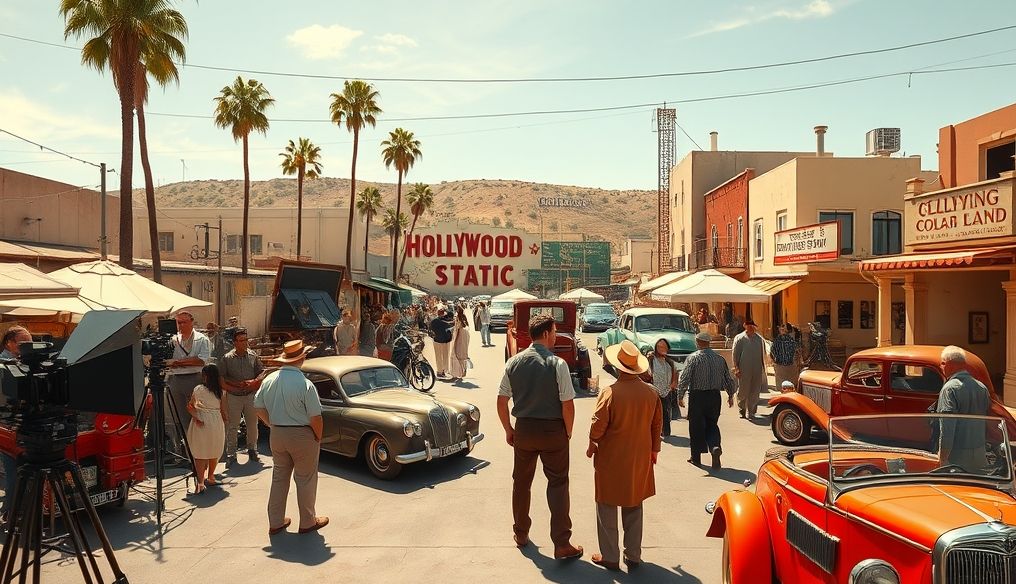How Did the Hollywood Film Industry Begin and Evolve into a Global Power?
Hollywood, a name that resonates around the world, is synonymous with dreams, cinematic magic, and entertainment. But how did this giant industry begin? Hollywood's journey from humble beginnings to a global entertainment hub is a fascinating story worth exploring.
Chapter 1: Humble Beginnings - Why California?
In the early 20th century, the film industry was in its infancy, mostly concentrated on the East Coast of the United States, specifically in New York and New Jersey. But soon, a group of independent producers and directors began to head west to California. Why California?
- Sunny Climate: California enjoyed a sunny climate year-round, allowing for outdoor shooting throughout the year, which was crucial in the early days of silent cinema.
- Geographical Diversity: California offered a diverse range of landscapes, from beaches and mountains to deserts and forests, making it an ideal location for filming a wide variety of movies.
- Cheap Land: Land in California was much cheaper than land on the East Coast, making it an attractive place for independent producers looking for affordable filming locations.
- Escape from Patents: New York and New Jersey were controlled by the Motion Picture Patents Company (MPPC), which controlled most aspects of the film industry through patents. Independent producers sought to escape this control by moving to California.
Chapter 2: Establishment of the First Studios
By 1910, the first film studios began to emerge in the Hollywood area, which was then just a small agricultural area outside of Los Angeles. Among the leading studios founded during this period were:
- Nestor Film Company: Founded by David Horsley, it was the first permanent film studio in Hollywood.
- Hollywood Film Laboratory: Founded in 1912, it was one of the first companies to offer film processing services.
- Universal Studios: Founded by Carl Laemmle in 1912, it quickly became one of the largest studios in Hollywood.
Chapter 3: The Era of Silent Cinema
The 1920s saw a significant boom in the silent film industry in Hollywood. Stars like Charlie Chaplin, Mary Pickford, Douglas Fairbanks, and Rudolph Valentino emerged and became global icons. This period was characterized by the production of innovative and influential films such as:
- "The Birth of a Nation" (1915): A controversial film by director D.W. Griffith, but it was also a milestone in film history due to its innovative cinematic techniques.
- "The Gold Rush" (1925): A classic silent comedy starring and directed by Charlie Chaplin.
- "Metropolis" (1927): An influential German science fiction film directed by Fritz Lang, which greatly influenced future films.
Chapter 4: The Emergence of Talking Cinema
In 1927, the film "The Jazz Singer" changed everything. This film was the first feature film to include spoken dialogue, leading to a revolution in the film industry. Studios had to invest heavily in new equipment and train actors to speak in front of the camera. Some silent film stars were unable to transition to talking cinema, while new stars emerged, such as Clark Gable, Greta Garbo, and Marlene Dietrich.
Chapter 5: The Golden Age of Hollywood
The Golden Age of Hollywood, which lasted from the late 1920s to the 1950s, is considered a period of creative and commercial prosperity. Five major studios (the "Big Five") dominated the industry: Paramount, Metro-Goldwyn-Mayer (MGM), Fox, Warner Bros., and RKO. These studios produced a large number of films that are still considered classics today, such as:
- "Gone with the Wind" (1939): An historical epic starring Clark Gable and Vivien Leigh.
- "Casablanca" (1942): A classic romantic film starring Humphrey Bogart and Ingrid Bergman.
- "The Wizard of Oz" (1939): A fantasy musical film starring Judy Garland.
Chapter 6: Challenges and Changes in the 1950s and 1960s
Hollywood faced a number of challenges in the 1950s and 1960s, including:
- The Rise of Television: The spread of television led to a decline in movie viewership.
- Antitrust Issues: Courts forced studios to relinquish control of movie theaters.
- The Blacklist: Fears of communism led Hollywood to blacklist many writers, directors, and actors.
However, Hollywood was able to adapt to these challenges by producing more ambitious and creative films, such as:
- "Ben-Hur" (1959): An award-winning historical epic.
- "Spartacus" (1960): An epic historical film directed by Stanley Kubrick.
- "2001: A Space Odyssey" (1968): A pioneering science fiction film directed by Stanley Kubrick.
Chapter 7: New Hollywood
In the late 1960s and early 1970s, a new generation of directors emerged who challenged Hollywood traditions and presented bolder and more realistic films. Among these directors were:
- Francis Ford Coppola: Director of "The Godfather" and "Apocalypse Now".
- Martin Scorsese: Director of "Taxi Driver" and "Raging Bull".
- Steven Spielberg: Director of "Jaws" and "E.T.".
- George Lucas: Director of "Star Wars".
Chapter 8: Hollywood Today - A Global Industry
Today, Hollywood has become a huge global industry. Major companies such as Disney, Warner Bros., Universal, Sony, and Paramount dominate the market. Hollywood increasingly relies on big-budget films (blockbusters) and films based on comic books and video games. Despite the challenges facing the industry, such as piracy and changing viewing habits, Hollywood remains a dominant force in the world of entertainment.
Chapter 9: The Future of Hollywood
The future of Hollywood is uncertain, but technology will certainly play a major role. Streaming services, virtual reality, and artificial intelligence will affect how films are produced, distributed, and consumed. Hollywood will have to adapt to these changes in order to remain relevant.
Chapter 10: The Legacy of Hollywood
Regardless of the challenges it faces, the legacy of Hollywood is undeniable. Hollywood has shaped popular culture around the world, inspired millions of people, and provided us with some of the greatest cinematic moments in history. Hollywood films will continue to entertain and inspire for generations to come.




